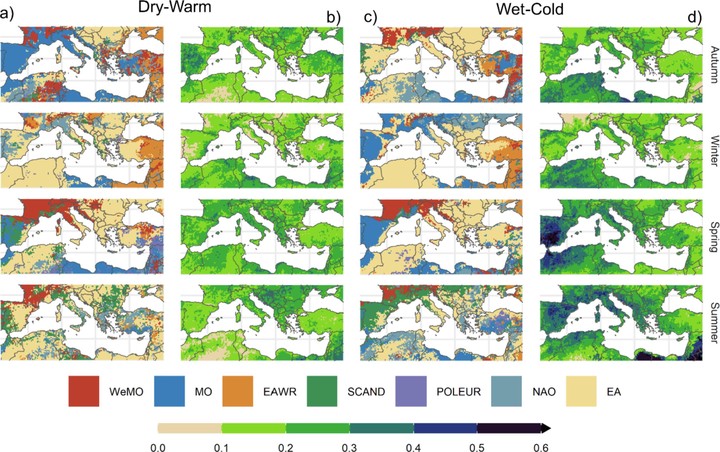Changes in compound monthly precipitation and temperature extremes and their relationship with teleconnection patterns in the Mediterranean

Abstract
Compound extremes have increasingly become the focus of research in recent years, due to the strong impact they have upon society and ecosystems. Few studies, however, address the role of teleconnection patterns in these compound extremes, and how the former can be used to predict the latter. The present study quantifies the changes observed in the monthly frequencies of Dry-Warm, Dry-Cold, Wet-Warm and Wet-Cold concurrent extremes in the Mediterranean basin during the 1951–2020 period, and assesses the effect of different regional, continental and oceanic teleconnections upon the frequency of such concurrent extremes. Results reveal a significant increase, especially, in dry-warm months in large areas of the Mediterranean basin, mainly in summer and spring, as well as a decrease in wet-cold extremes in these seasons. On the other hand, the positive phase of the Mediterranean Oscillation (MO) has a strong capacity to drive dry-warm months in the western Mediterranean basin, as well as wet-cold extremes in the southern-east part of the Mediterranean basin. This role becomes inverted during the negative phase of this teleconnection. Furthermore, due to its subtropical linkage, the positive phase of the East Atlantic (EA) oscillation also plays an important role in accounting for the occurrence of dry-warm months in most of the Mediterranean basin, especially in the west and the north. During its negative mode, the configuration of the EA dipole favours the occurrence of wet-cold months, especially in the north and western part of the basin. The East Atlantic/Western Russia oscillation proved to be highly capable of inferring the ocurrence of dry-warm and wet-cold events in the eastern Mediterranean. The other teleconnections analysed (the North Atlantic Oscillation (NAO), the Western Mediterranean Oscillation (WeMO), and the Scandinavian (SCAND) an Polar-Eurasia (POLEUR) oscillations) played a minor role in driving these monthly concurrent extremes. The results provided by the present paper are intended to guide future research addressing the potential of teleconnection patterns to drive the temporal variability of compound extremes.